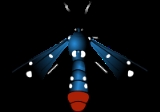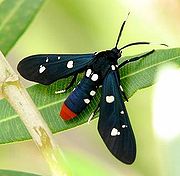
Syntomeida epilais
Encyclopedia
The Polka-Dot Wasp Moth (Syntomeida epilais) is a species of moth
thought to be native to the Caribbean
. The species is also called the Oleander Moth after the Oleander
plant, from which its young feed. Like most wasp moths, these moths are day fliers.
And they prefer neotropic areas, to which they are native. The North American subspecies is S. epilais jucundissima, which is locally common in all areas of Florida, and has been seen as far north as Savannah, GA.
 They are dark metallic blue with a couple of white polka-dots dotting the wings and upper abdomen. The tip of the moth's abdomen is bright red; it looks like a very dangerous wasp, but in fact is a harmless moth.The caterpillars are orange or dark orange with long black hairs. The caterpillars look dangerous, but the setae do not inflict any harm.
They are dark metallic blue with a couple of white polka-dots dotting the wings and upper abdomen. The tip of the moth's abdomen is bright red; it looks like a very dangerous wasp, but in fact is a harmless moth.The caterpillars are orange or dark orange with long black hairs. The caterpillars look dangerous, but the setae do not inflict any harm.
 The larva
The larva
e stage of the Polka-Dot wasp moth, commonly called the Oleander caterpillar, is widely known for its gluttonous appetite. The caterpillar feeds in almost any location (excepting California) where its food, the Oleander
plant, can be found. They are gregarious and can cause damage from minor to severe. It may also feed on devil's potato plants, which are believed to be its native food before the Oleander plant was introduced to the Americas by Spanish settlers in the seventeenth century.
Moth
A moth is an insect closely related to the butterfly, both being of the order Lepidoptera. Moths form the majority of this order; there are thought to be 150,000 to 250,000 different species of moth , with thousands of species yet to be described...
thought to be native to the Caribbean
Caribbean
The Caribbean is a crescent-shaped group of islands more than 2,000 miles long separating the Gulf of Mexico and the Caribbean Sea, to the west and south, from the Atlantic Ocean, to the east and north...
. The species is also called the Oleander Moth after the Oleander
Oleander
Nerium oleander is an evergreen shrub or small tree in the dogbane family Apocynaceae, toxic in all its parts. It is the only species currently classified in the genus Nerium. It is most commonly known as oleander, from its superficial resemblance to the unrelated olive Olea, but has many other...
plant, from which its young feed. Like most wasp moths, these moths are day fliers.
And they prefer neotropic areas, to which they are native. The North American subspecies is S. epilais jucundissima, which is locally common in all areas of Florida, and has been seen as far north as Savannah, GA.
Description

Reproduction and breeding
Females contact male polka-dot wasp moths by means of ultrasonic signals. On the branch, the sound travels, and then the male follows the sound to his new mate. When he reaches her, he emits an answering signal.Pest

Larva
A larva is a distinct juvenile form many animals undergo before metamorphosis into adults. Animals with indirect development such as insects, amphibians, or cnidarians typically have a larval phase of their life cycle...
e stage of the Polka-Dot wasp moth, commonly called the Oleander caterpillar, is widely known for its gluttonous appetite. The caterpillar feeds in almost any location (excepting California) where its food, the Oleander
Oleander
Nerium oleander is an evergreen shrub or small tree in the dogbane family Apocynaceae, toxic in all its parts. It is the only species currently classified in the genus Nerium. It is most commonly known as oleander, from its superficial resemblance to the unrelated olive Olea, but has many other...
plant, can be found. They are gregarious and can cause damage from minor to severe. It may also feed on devil's potato plants, which are believed to be its native food before the Oleander plant was introduced to the Americas by Spanish settlers in the seventeenth century.

